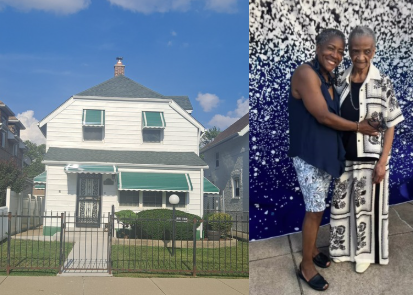Community Resources: DIY Ways to Seal and Insulate Your Home
Making sure your home is well sealed and insulated is one of the best things you can do to make sure your home is efficient, healthy, and resilient. Sealing crack and gaps and insulating your home keeps the outside air out and the inside air in, and leads to less mold, pollen, and insects in your house. Plus, air sealing and insulation keeps out drafts and keeps your home the temperature you want it to be, so you don’t need to spend extra money heating and cooling your home!
You can work with your local utility, like ComEd or Ameren, to get a home assessment and determine what upgrades are most cost-effective and energy-saving for your home. If you’re waiting to schedule your assessment, we’ve got you covered with easy projects that you do yourself at home to seal your home! These DIY methods can help you save 5-10% of energy at your home.
Use rope caulk to seal air leaks around windows
Windows are responsible for 25-30% of heat lost in a home. This can happen directly through the glass, but also through gaps around the windowsill and frame.
Rope caulk is an inexpensive way to seal your windows so that heat doesn’t escape, and it’s very easy to use compared to regular caulk. Thirty-five feet of rope caulk costs around $7.
Key Takeaways:
- Windows are responsible for 25-30% of heat lost in a home
- Rope caulk is an easy and inexpensive way to seal windows and prevent heat loss
Use foam tape to seal gaps between doors and doorframes
Like windows, doors are another source of heat loss in a home that is easy to seal. Sealing the gap between the door and doorframe using foam tape, also called weatherstripping, is an inexpensive way to prevent this heat loss. Weatherstripping costs around $5 at most hardware stores.
Key Takeaways:
- Doors are another source of heat loss in a home
- Foam tape is an inexpensive way to to seal between your door and doorframe
Seal and insulate your attic access point
Heat rises – it’s one of the first things we learn in science class! Because hot air rises, attics are a big source of heat loss during the winters and are a great opportunity to save on energy loss.
The most effective way to prevent this heat loss is to insulate your attic. However if you’re not ready to fully insulate, you can still prevent heat loss by sealing the access point to your attic.
If you have an attic with a trapdoor and ladder, simply measure the dimensions of the trapdoor and purchase an insulated cover to fit. If you’re want to try it yourself, you can construct a box of plywood to place over the door and line the inside of the box with quality attic insulation material.
Key Takeaways:
- One big place where heat loss in a building happens is through the attic and roof
- An insulated cover is a cost-efficient way to prevent heat loss through your attic’s access point
Install electrical socket sealers
Most heat loss in a home happens through the walls, and some of that is lost through electrical sockets.
Luckily, electrical sockets are one of the cheapest things to insulate in your home. Socket sealers are made of insulating material, such as polyethylene foam, that prevents air from escaping through the empty space in an electrical socket. A pack of 24 socket sealers costs just under $5 at a local department store.
Key Takeaways:
- Walls are the biggest source of heat loss at home, some of which is lost through electrical sockets.
- Socket sealers are very inexpensive and easy to install
Hang up thermal curtains
Thermal curtains are made of material that prevents heat from moving through it. Often made from a layer of wool or cotton, followed by acrylic foam and a breathable outer layer to prevent condensation from forming, these curtains prevent heat from escaping through the windows. Since heat gain and loss through windows are responsible for 25-30% of heating and cooling energy, putting up thermal costs is an easy cost effective way to reduce heat loss!
The cost of thermal curtains is dependent on the size of your windows and the quality of insulation in the curtains. Because of these two variables the cost of putting up thermal curtains can vary quite a bit, but you expect to pay about $15 for each curtain. Do some research online to see what curtains work best for your windows before making a purchase!
Key Takeaways
- Thermal curtains prevent heat and energy loss
- Approximately a third of energy used on heating and cooling your home is lost through heat entering or escaping through your windows, and thermal curtains prevent this heat transfer
- Prices vary, but you can expect to spend about $15 per window
Learn More
Connect with Elevate by following us on Instagram and Facebook @elevatecommunityevents. Want to be featured in an upcoming story? Post photos and videos of your energy efficiency lifestyle by using the hashtag #elevatecommunityevents.
We also encourage you to get in touch with a Community Resource Coordinator to see if you’re eligible for an energy assessment through Illinois Home Weatherization Assistance Program (IHWAP). Send us a message through Instagram or Facebook, or call us at (833) 204-1992.
Want to share this valuable lesson with others in the community? Share this article with family, friends, and coworkers, or reach out to Elevates community resource team for a virtual, live presentation!



